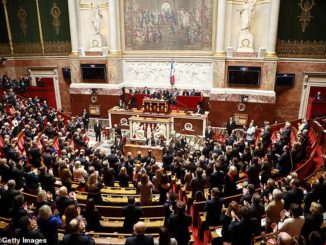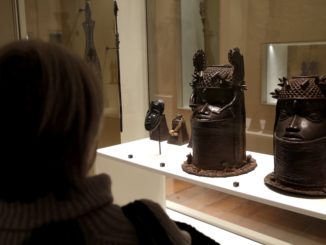
After years of steadfast resistance, the French government declared on Nov. 23 that it would return 26 sculptures and other artifacts to the Republic of Benin, a nation in West Africa formerly colonized by France. This move, ordered directly by President Emmanuel Macron, is not just a policy reversal — it also marks a startling break with a cherished national self-conception.
As Macron himself has put it, France is among the very few countries in the world “obsessed with universality,” what he admitted some might see as a “pretension … to speak on behalf of the whole of humanity.” It is a telling choice of words: “obsessed” and “pretension.” Unlike his predecessors, Macron is willing to acknowledge the dark side of France’s past as an imperial power, and to seek ways of making amends for it.
To understand the high stakes of this decision, it’s worth taking a closer look at one of the most famous objects due to be returned, a larger-than-life-size iron sculpture of a warrior now on display at the Louvre.
From the early 1600s until its conquest by the French in 1894, much of the southern portion of the current Republic of Benin was an independent kingdom called Dahomey, dominated by the Fon ethnic group. According to the art historian Suzanne Preston Blier, the iron figure now in the Louvre was commissioned by King Glele, who ruled from 1858 to 1889, and made by the sculptor Akpele Kendo Akati. It stood in a special temple in the royal palace in Abomey, the kingdom’s capital, where it served as a powerful weapon of symbolic defense, enacting the ruler’s connection to Gou, god of iron and war.
Dahomey’s conquest by France was part of what’s known as the scramble for Africa that took place from 1881 to 1914. The kingdom’s location between what would become German Togoland and British Nigeria made it a key strategic asset for the French, who established a foothold in the region after a brief war in 1890. After four years and two wars, it became become part of the French empire.
The French first encountered the iron figure in the early stages of their 1892 invasion, when they captured the port city of Ouidah. It seems likely the figure had been moved there to lend its symbolic power to the city’s defenses. Eugène Fonssagrives, a French captain, seized it as spoils and donated it to the French nation in 1894.
For years thereafter, the figure was on display in Paris at the Musée d’Ethnographie du Trocadéro. At first, it was most notable as a trophy from a war vividly covered in the French penny press. Illustrated papers had regaled readers with stories of the gigantic but “crude” statues that Dahomean soldiers took with them into battle — proof, one journalist said, that “in Dahomey the critical spirit is nonexistent.”
Eventually, it became an icon of the avant-garde. Picasso saw it during the 1907 visit that changed the history of Western art by inspiring the painting “Les Demoiselles d’Avignon.” Writing in 1912, Guillaume Apollinaire, a leading advocate of cubism, proclaimed the figure “without doubt the most unexpected and graceful work of art to be seen in Paris.”
Over the course of the 20th century — and especially after 1945, as the French empire began to disintegrate and French global political power waned — it became increasingly tempting for makers of French cultural policy to see that acknowledgment of African art’s aesthetic value as another triumph of the nation’s famous capacity to “speak on behalf of the whole of humanity.” Imperial conquest might have brought African objects to Paris, but French aesthetic refinement gave those objects a new value that seemed to transcend the brute realities of geopolitics. Reverence for captured objects seemed to redeem the act of conquest.
In 2000, the iron figure made its way to the Louvre. Advocates of the avant-garde had been pressing to include African, Oceanic and Native American art in the great museum since the 1920s, but previous efforts had failed. Things only changed when the art dealer Jacques Kerchache turned to politics. He self-consciously echoed the 1789 Declaration of the Rights of Man and Citizen. Including these objects in the Louvre, he argued, was a necessary recognition “that all the world’s masterpieces are born free and equal.”
The Republic of Benin, however, disagreed with this rosy French self-conception. In 2016, the country formally called for the iron figure’s restitution, along with a group of other objects captured in the same conflict. The French government summarily rejected the claim, citing a law that declared property in the national museums to be “inalienable.”
But Macron has changed this story. He commissioned a report on the issue from the Senegalese economist Felwine Sarr and the French art historian Bénédicte Savoy. They have come out emphatically in favor of restitution. Invoking the brutal legacy of colonialism, Sarr and Savoy argue that responding positively to such requests will do much to foster “future equitable relations” between France and its former colonies in sub-Saharan Africa.
This new cultural policy is disturbing to many in the art world. Didier Rykner, founder of the website La Tribune de l’Art, worries that it will open a “Pandora’s box” of restitution claims from other parts of the world. Jean-Jacques Aillagon, a former minister of culture, has gone so far as to denounce the Sarr-Savoy report as “the law of an eye for an eye in cultural diplomacy,” and as such, a threat to the “progress of universal civilization.”
The terms of the debate can sound forbiddingly abstract. On one side, “universal civilization,” on the other, what Sarr and Savoy call “a new relational ethics between peoples.” What is at issue, however, is concrete: not only the fate of some 90,000 objects, but also an enduring conception of France’s place in the world.
The opponents of restitution are drawing on a vision of French identity with roots in the Revolution of 1789. If France is founded on universal principles of human rights, it has a special mission in the world as a model of “civilization” from which all peoples can draw inspiration. In this view, maintaining objects from elsewhere in French museums is safeguarding them for the good of humanity as a whole.
Advocates of restitution see things differently. The idea of “universal civilization” itself, they contend, is a Western invention, not a fact. Proclaiming that idea’s supremacy over others is an act of presumption. Worse, it reflects the same sort of domineering arrogance that motivated European colonial conquest in the first place.
Of course, the challenge is that, as the story of Akpele Kendo Akati’s warrior figure shows, there is some validity to both of these heritage stories. The difficulty is finding a way to split the difference between them, which is what makes Macron’s decision so important.
His willingness to acknowledge the contradictory nature of the ideal of France as “the universal nation” is a striking break with the past. It is also an important step forward in historical understanding, because it allows for the recognition of an uncomfortable truth: that France once used the notion of its unique “civilizing mission” to give a humanitarian veneer to what was in fact a vast program of overseas conquest and subjugation.
With the anti-immigrant, populist right on the rise across Europe, however, this questioning of “universality” also entails a risk. Will it lay the groundwork for a new kind of openness to the world? Or will it encourage a turn inward, a sense that France should keep to itself rather than welcoming foreigners and borrowing creatively from them, as it has done so fruitfully in the past?
–



